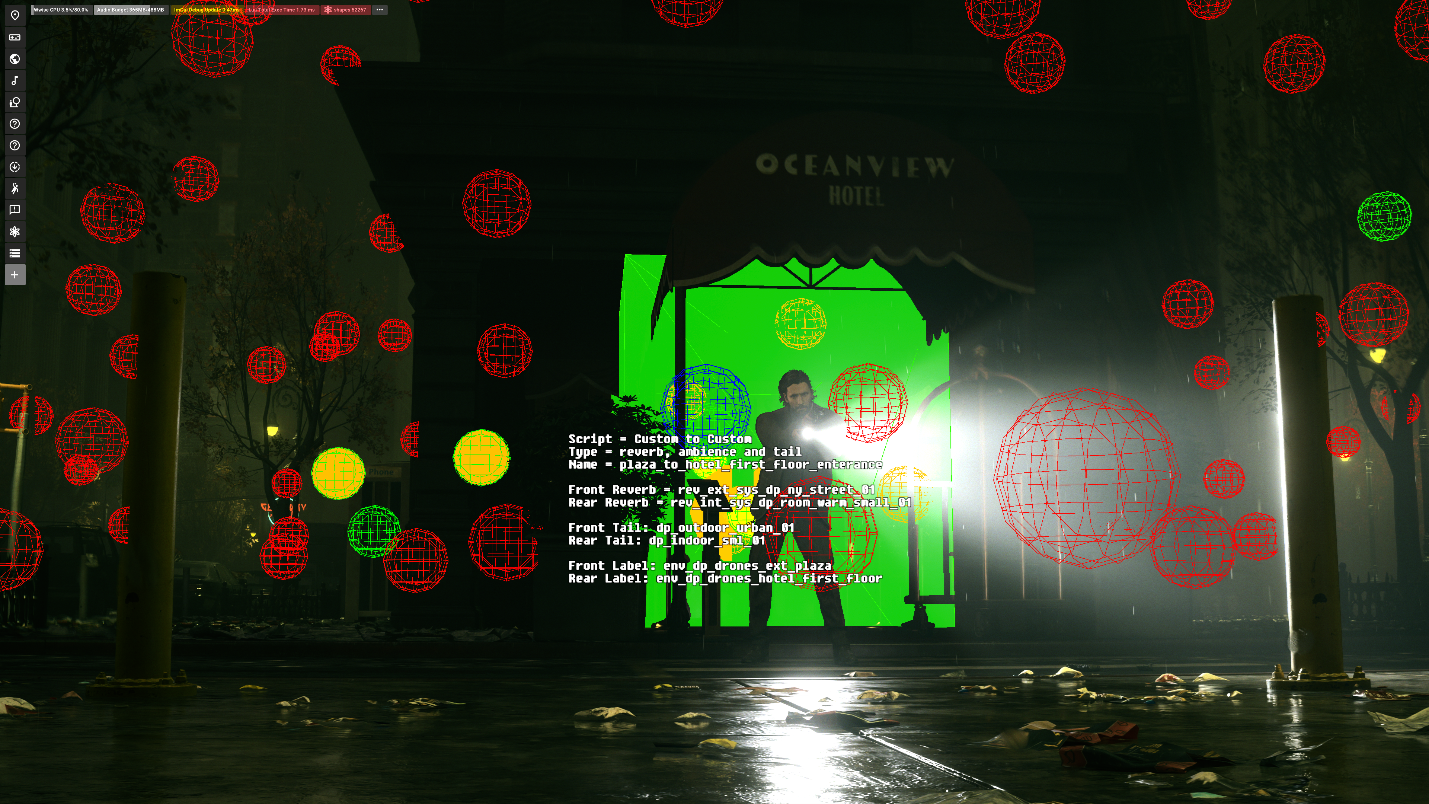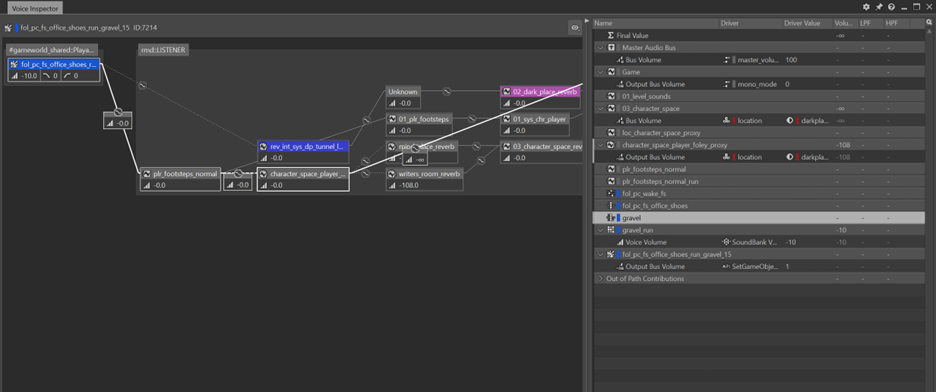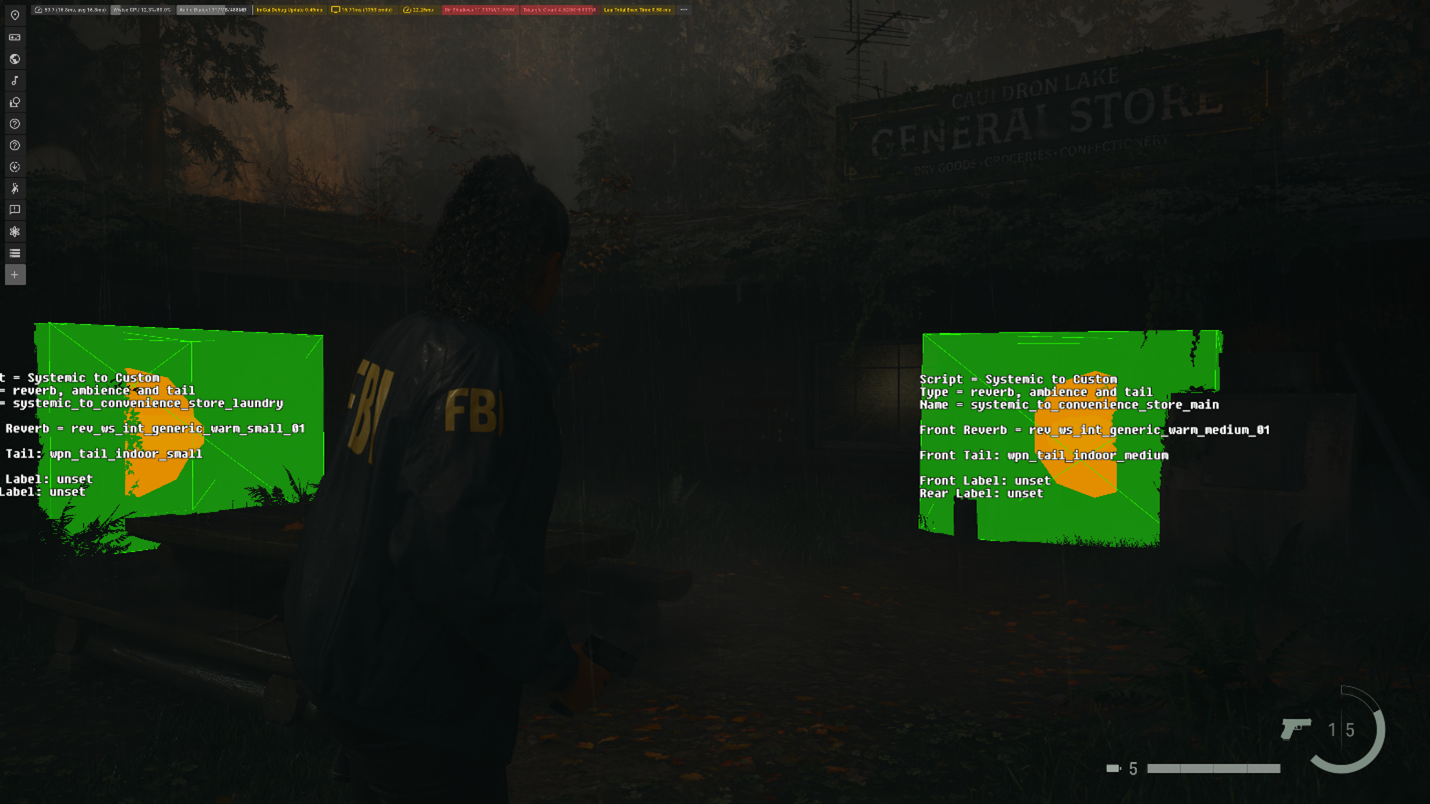Inside the Mind of Alan Wake 2: A Series
Inside the Mind of Alan Wake 2 is a deep dive into the creative and technical processes that shaped the game’s audio experience. This blog series explores the meticulous decisions, challenges, and innovations behind Alan Wake 2’s soundscape. From crafting dynamic dialogue and immersive Echoes to the vital role of audio QA and the game’s unique profiling system, step inside the minds of the audio team who brought this world to life.
In the first installment, Senior Dialogue Designers Arthur Tisseront & Taneli Suoranta explored the intricacies of dialogue implementation in Alan Wake 2, breaking down the interplay between spoken and narrated dialogue. If you missed it, check it out here: Inside the Mind of Alan Wake 2: Distinguishing Dialogue.
In the second installment, Principal Audio Designer Tazio Schiesari took us behind the scenes of designing the sound of Echo interactions in Wwise, sharing how granular synthesis helped shape an evolving, interactive soundscape. You can give that a read here: Inside the Mind of Alan Wake 2: Designing Echoes in Wwise.
And in this final installment, we step into to the world of Audio QA. Ensuring Alan Wake 2’s intricate audio systems worked seamlessly required dedicated testing. From footsteps in flooded areas to systemic ambience transitions, Audio Test Engineer Adam Butterworth reveals how Audio QA helps diagnose and solve complex audio challenges. He'll dive into:
- What is Audio QA & why does it matter?
- How did debugging tools & Wwise help pinpoint audio issues?
- Real-world examples of audio bugs, and how they were fixed.
Let’s dive into the critical role of Audio QA in Alan Wake 2!

Figure 1: Alan Standing at the Oceanview Hotel with the acoustic probes debug enabled
Introduction: The Role of Audio QA
Hello! Before we start this dive into audio QA on Alan Wake II, I should introduce myself.
I’m Adam Butterworth and I work at Remedy Entertainment as an Audio Test Engineer with the audio and QA teams. I joined Remedy in January 2021 as a QA tester, but very quickly transitioned to working with the audio team, eventually creating the Audio Test Engineer role.
What is Audio QA?
Audio QA is a Quality Assurance role that is dedicated to the audio team, mainly working with the audio designers and technical audio team.
The goal of audio QA is to not just find audio issues, but to diagnose their root cause. QA could find an issue and report it (‘Oh, you cannot hear this sound in a room’), but audio QA, with a deep understanding of audio principles and the audio systems within the engine and Wwise, can report the issue with its cause (‘There are missing acoustic probes within the building’). This saves development time, as the developer will now know what to do without having to spend time looking into the issue, and can allow the developer time to work on that audio feature you requested two milestones ago! This is the value that a dedicated audio QA can bring.
So, we’re in-game and found an issue. Now what?
Wwise and Audio QA
Water is a major part of Alan Wake II, and both Alan and Saga spend long sections traversing through it. One issue I discovered during development involved footsteps when entering the murder site as Alan during Initiation 2: Casey.
As Alan leaves the crawl space, he enters a large, cavernous flooded space. The issue? Water footsteps weren’t triggering. The first thing I did was check the Wwise Profiler session to see what was going on when the player walked through the area.
Figure 2 video: Alan walking through the murder scene with incorrect footsteps and the Wwise Profiler running.
Using the filter option, I reduced what was visible in the Capture Log and Advanced Profiler to only show relevant audio - In this case, fol_pc_fs (Foley_PlayableCharacter_FootSteps).

Figure 3: Wwise Profiler filtered to show footsteps
This confirmed that no water footsteps were triggering. The next step was to determine why, and this is where an understanding of how a system works within the game is crucial.
There were multiple potential causes. To start, there is the physical material of the object. For water, we obviously want the water plane to be tagged as “Water”. There is also the audio setup, which is a Switch Container containing (at the time of this bug) “Shallow”, “Ankle”, “Calf” and “Knee”, controlled by a player depth RTPC.
Using an in-game physical material debug tool, I was able to confirm that the water was correctly marked as “Water”. That meant the issue lay with the fs_wading_layer setup.
Next, I checked the voice graph. Selecting the footstep sound that was playing, I opened the Voice Inspector and confirmed that the “Gravel” switch was being triggered when the fs_office_shoes switch was triggered.

Figure 4: Voice Inspector open, showing "Gravel" as the footstep material
Now that I knew that the physical material was correct in-game, but that "Gravel" was being told to play, it was time to look into the fol_pc_office_shoes Switch Container.
The first step here was to confirm the assigned object for water. It was assigned correctly, but tracking the player_water_depth RTPC in-game revealed that the depth value wasn’t high enough to trigger water footsteps - instead, it was playing sounds for the material under the water.
This was fixed with the level design team lowering the ground, making the water “deeper” and ensuring the correct footstep sounds were played.
Figure 5: Video showing Alan moving through the murder scene with the bug fixed and water depth RTPC being tracked correctly.
Ambience Testing

Figure 6: Saga stood at the Cauldron Lake General Store with the ambience debugger enabled
This was one of the areas of the game I enjoyed testing the most.
During this section, I’ll talk about the systemic to custom (exterior to interior) setup for interiors.
The audio ambience system in Alan Wake 2 is partly systemic but also involves a lot of manual setups. When you’re outside, the ambience you hear is driven systemically by factors in the environment, such as how many trees are surrounding the player. This variable (in-part) controls the blend between different ambience beds that can be heard as you move around and explore.
Weather is also driven systemically. For example, in Cauldron Lake, there are two wind systems. One RTPC is a constant value that is set to whatever the wind value is, and then there is a modulated RTPC that plays gusts of wind.
But when you enter an interior area, custom-designed ambience beds are triggered, chosen by our sound designers depending on the space you’ve entered. In the doorways are trigger boxes that, when entered, set these ambiences, along with reverbs and the sounds used for gunshot tails. As you move through these trigger boxes, an RTPC called ‘Interiority’ is updated. It is set on a scale between 0 and 1, which then drives the mix of these elements as you enter a new room or building.
Figure 7 video: This shows Saga moving from outside the General Store and through different room sizes, firing the weapon to demonstrate the different weapon tails.
As you can see, there are many places where bugs could be introduced here. For example, the rain system partially works similarly to the wind system. There's a modulated value that takes the fixed value and varies it based on how we choose - then that RTPC drives the Blend Container, which is a mix of light and heavy assets, with a crossfade in the middle.
One issue found was in Return 2. During the return to the Witch's Ladle with the heart, the rain progression was not behaving as intended. When the fight in the water ends, the rain and wetness values decrease, but it was possible to trigger the cinematic at the Witch's Ladle before this had reached 0, resulting in rain being audible during the cinematic while Saga and the world appeared dry. Then during the cinematic, the value would increase immediately to 70.
Figure 8 video: This video shows the rain progression values as Saga reaches the Witch's Ladle location to trigger a cutscene. As the Cinematic starts, notice how the rain value is still decreasing but the wetness value was at 0, resulting in the bug.
Outro
Thanks for taking the time to read this.
I hope you all enjoyed reading about some of the issues encountered in the development of Alan Wake II. As you can see a lot of ‘audio bugs’ are usually not audio bugs - rather, audio is often a symptom of a deeper issue, as we saw with the water depth detection and the rain progression.
Once again, dedicated audio QA, with a deep understanding of how audio works, helps reduce misreported bugs and speeds up fixes by ensuring issues are sent to the correct department.



댓글
Steven Wilson
February 28, 2025 at 02:40 pm
Great job Adam! very interesting read and well written blog.